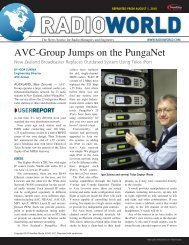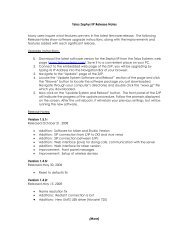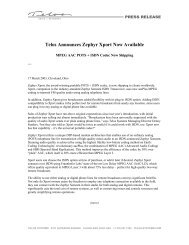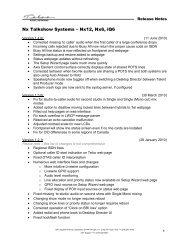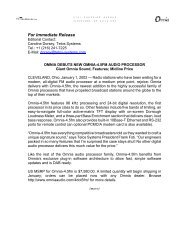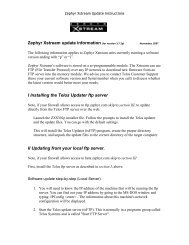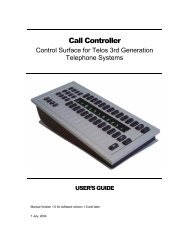NOW! 12-13 - Telos
NOW! 12-13 - Telos
NOW! 12-13 - Telos
You also want an ePaper? Increase the reach of your titles
YUMPU automatically turns print PDFs into web optimized ePapers that Google loves.
Figure-16, MPX Peak Control, SSBSC<br />
Figure-17, MPX Spectra, SSBSC<br />
TECHTALK BLOG<br />
TELOSALLIANCE.COM/BLOG<br />
SSBSC AND DECODED SIGNAL-TO-NOISE<br />
Another known challenge for the system is the compromised sig-<br />
nal-to-noise (SNR) level when broadcasting stereo. FM transmis-<br />
sion noise will rise in a triangular fashion at 6dB per octave over<br />
the channel’s passband range of 0Hz-99kHz. This is the product<br />
of the modulation/demodulation process. The use of preempha-<br />
sis in transmission, along with complementary deemphasis in<br />
demodulation, improves the high frequency noise response. It<br />
has been generally accepted that FM-Stereo suffers a 23dB over-<br />
all noise penalty compared to monophonic broadcasting. This is<br />
due to the rising noise loor over the subcarrier range of 23kHz<br />
– 53kHz, as compared to the SNR over the range of 0Hz – 15kHz,<br />
which is used for mono. Figure–18 is an illustration of the com-<br />
posite baseband signal, and it shows the 6dB/octave noise loor<br />
slope of an FM channel, as it would appear at the output of an IF<br />
section in a receiver.<br />
Figure-18, FM System Noise Plot<br />
BROCHURES<br />
OMNIAAUDIO.COM/BROCHURES<br />
SOFTWARE UPDATES<br />
OMNIAAUDIO.COM/SOFTWARE<br />
It has been theoretically calculated [5], and technically demon-<br />
strated, there is roughly a 4dB broadband improvement in recov-<br />
ered signal-to-noise performance of the SSBSC transmit/receive<br />
function, as compared to the conventional DSB transmit/receive<br />
iteration. When transmitting SSBSC, and decoding only the lower<br />
sideband spectra (23kHz – 38kHz), an interesting event occurs.<br />
Stereophonic noise is about 10dB better for decoded 15kHz. This<br />
is due to the frequency inversion of the lower sideband. The tri-<br />
angular noise is lower at 23kHz, where 15kHz resides in the lower<br />
sideband region of the L-R signal, as compared to lower frequen-<br />
cies, which are located near 38kHz and triangular noise is greater.<br />
Figure-19 is the recovered noise loor of a DSBSC transmission/<br />
reception. Compare the amplitude of the noise loor at 15kHz in<br />
this igure with that of Figure-20, which is the recovered noise<br />
loor of a SSBSC transmit/receive system.<br />
Figure-19, Recovered Noise, DSB<br />
Figure-20, Recovered Noise, SSB<br />
Consider the annoying hiss a listener hears at the output of the<br />
FM receiver. The predominant range of audible hiss is the high<br />
frequencies. As observed in Figure-18, there’s an improvement<br />
of 10dB in signal-to-noise in the audible hiss range. Hopefully,<br />
this might encourage receiver manufacturers to consider adding<br />
SSB decoding into conventional receivers. The above test results<br />
were realized using a SSBSC stereo decoder designed and imple-<br />
mented, real time, in MatLab by the author.<br />
FIND A DEALER<br />
OMNIAAUDIO.COM/BUY<br />
AUDIO PROCESSING | FM | FM+HD | AM | MULTICASTING | CODED AUDIO | STUDIO APPLICATIONS<br />
OMNIAAUDIO.COM<br />
57






